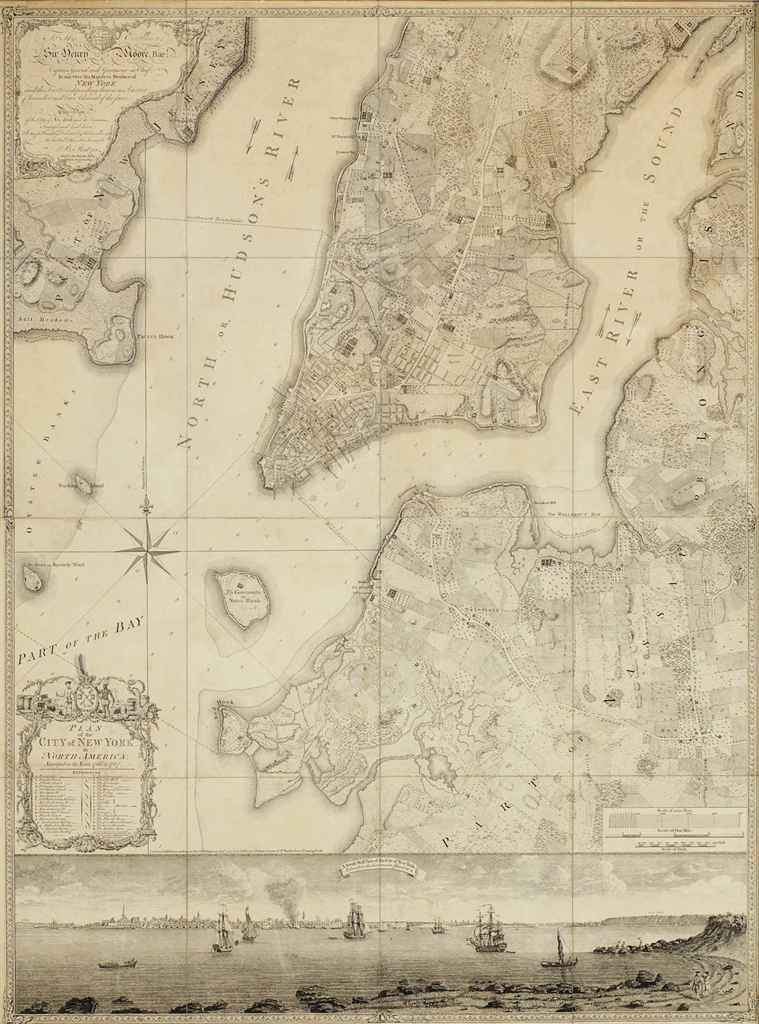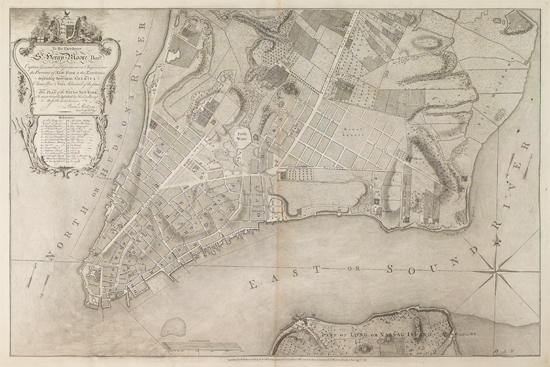RATZER, BERNARD Plan of the City of New York in North America, surveyed in the years 1766 & 1767. London: Faden & Jeffreys, 1776. Second issue (after the 1770 issue known in three copies). Engraved map on three sheets of thick laid paper joined, with the imprint of Faden & Jeffreys to the lower sheet and also to the lower margin of the top sheet (covered when joined), inset view of New York from Governors Island across the bottom of the lower sheet, with the inked numerals "11" on the verso at top right, likely a placement indicator for an atlas. Overall 48 1/2 x 35 3/4 inches (123 x 91 cm); framed. Some discreet repair on verso to fold intersections, some faint toning, a fresh example. "Perhaps the finest map of an American city and its environs produced in the eighteenth century. In its final form, its geographic precision combined with highly artistic engraving was unsurpassed in the urban cartography of its day ... The Ratzer Map evokes a halcyon period in the history of Manhattan" (Manhattan in Maps, p. 73). In the highly charged political atmosphere following the 1765 Stamp Act, Lieutenant Bernard Ratzer, a skilled surveyor and engineer in the Royal American Regiment, continued the survey of Manhattan begun by John Montressor in 1766. The following year Ratzer issued his plan of the lower portion of Manhattan island, known as the "Ratzen" plan for the misspelling of his name. Ratzer continued to survey the areas surrounding the city and in 1769 was commissioned by New York Governor Henry Moore to survey the border between New York and New Jersey, likely the reason the present map is dedicated to Moore. His survey complete, Ratzer's expansive map provides a very accurate view of the streets of lower Manhattan and depicts the farms, roads and topography reaching to approximately present day 50th Street as well as parts of Brooklyn, Long Island and New Jersey. Paired with the idyllic panoramic view of the city from Governors Island, Ratzer's finished map is a cartographic and artistic tour-de-force and a wealth of information of the colonial city on the brink of revolution. Not a commercial success, the 1770 issue of Ratzer's map is known in only about three copies but was re-issued with the imprint of Faden & Jeffreys in 1776 as war became imminent. As few maps accurately portrayed the topography of the region, Ratzer's Plan was used by British officers and is frequently encountered dissected and folded for easier use (see the Percy copy, sold 2011). Further copies of the map were included in some but not all copies of Faden's 1777 North American Atlas and the fold lines of the present copy suggest it extracted from this atlas. Stokes, Iconography ("one of the most beautiful, important and accurate plans of New York."), p. 341; Schwartz/Ehrenberg The Mapping of America, p. 192; Cohen/Augustyn Manhattan in Maps p. 73. C Estate of Leo Hershkowitz
RATZER, BERNARD Plan of the City of New York in North America, surveyed in the years 1766 & 1767. London: Faden & Jeffreys, 1776. Second issue (after the 1770 issue known in three copies). Engraved map on three sheets of thick laid paper joined, with the imprint of Faden & Jeffreys to the lower sheet and also to the lower margin of the top sheet (covered when joined), inset view of New York from Governors Island across the bottom of the lower sheet, with the inked numerals "11" on the verso at top right, likely a placement indicator for an atlas. Overall 48 1/2 x 35 3/4 inches (123 x 91 cm); framed. Some discreet repair on verso to fold intersections, some faint toning, a fresh example. "Perhaps the finest map of an American city and its environs produced in the eighteenth century. In its final form, its geographic precision combined with highly artistic engraving was unsurpassed in the urban cartography of its day ... The Ratzer Map evokes a halcyon period in the history of Manhattan" (Manhattan in Maps, p. 73). In the highly charged political atmosphere following the 1765 Stamp Act, Lieutenant Bernard Ratzer, a skilled surveyor and engineer in the Royal American Regiment, continued the survey of Manhattan begun by John Montressor in 1766. The following year Ratzer issued his plan of the lower portion of Manhattan island, known as the "Ratzen" plan for the misspelling of his name. Ratzer continued to survey the areas surrounding the city and in 1769 was commissioned by New York Governor Henry Moore to survey the border between New York and New Jersey, likely the reason the present map is dedicated to Moore. His survey complete, Ratzer's expansive map provides a very accurate view of the streets of lower Manhattan and depicts the farms, roads and topography reaching to approximately present day 50th Street as well as parts of Brooklyn, Long Island and New Jersey. Paired with the idyllic panoramic view of the city from Governors Island, Ratzer's finished map is a cartographic and artistic tour-de-force and a wealth of information of the colonial city on the brink of revolution. Not a commercial success, the 1770 issue of Ratzer's map is known in only about three copies but was re-issued with the imprint of Faden & Jeffreys in 1776 as war became imminent. As few maps accurately portrayed the topography of the region, Ratzer's Plan was used by British officers and is frequently encountered dissected and folded for easier use (see the Percy copy, sold 2011). Further copies of the map were included in some but not all copies of Faden's 1777 North American Atlas and the fold lines of the present copy suggest it extracted from this atlas. Stokes, Iconography ("one of the most beautiful, important and accurate plans of New York."), p. 341; Schwartz/Ehrenberg The Mapping of America, p. 192; Cohen/Augustyn Manhattan in Maps p. 73. C Estate of Leo Hershkowitz



.jpg)


.jpg)
.jpg)

Testen Sie LotSearch und seine Premium-Features 7 Tage - ohne Kosten!
Lassen Sie sich automatisch über neue Objekte in kommenden Auktionen benachrichtigen.
Suchauftrag anlegen